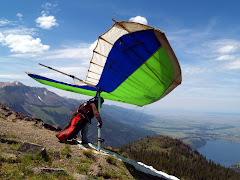Ken and I decided to fly this weekend (weather permitting) even if it meant a short flight. He hadn't flown since Labor Day, and it was shortly after that I dislocated my shoulder & I'd only gotten one flight since then. My flight was on my big floater and I hadn't flown my U2 in three months, so I'd planned to see if I still remembered how to fly a hotter wing.
It's much safer to get a flight in periodically, even a short 'sledride', to stay in practice. It is true that more flights mean a higher probability of having an accident, but I believe that the odds are more than offset by keeping one's skills polished. Launches and landings are the most difficult part of any flight, and even the most brief sledder allows the same opportunity to practice the transition from earth to sky and vice versa as an extended flight.
As is often the case, late fall/early winter weather in Grants Pass means fog, and Sunday morning was no exception. The hope is that the ambient air temperature will rise enough by noon or so that it will burn off, but sometimes that just doesn't happen. I called Ken around 10 am and he reported that the fog was just as thick at his house in Eagle Point. Neither of us were optimistic about the flying conditions, but we decided to throw the gliders on and give it a shot anyway. At the very least, we'd get a chance to see what kind of improvements Rick had made to the north launch.
As I got farther from Grants Pass the fog seemed to stay just as thick, but as I neared Applegate, I began to see hints of sunshine. On the far side of Applegate, the clouds parted and the sky became a brilliant blue. The wind direction in the valley even seemed favorable for a launch. Ken and Marti were at the parking area when I got there and were as amazed as I that the weather was so beautiful where we were. They had also driven through fog all the way to Jacksonville, and it seemed that the only clear area was a ten-mile radius around Woodrat Mtn.
We headed up the mountain and stopped at midlaunch to see what Rick was working on. He and Don were contemplating a large tree in front of launch that the BLM had marked for removal. The light wind was coming up launch, but the fear was that the prevailing wind might actually be coming over the back. Rick filled a helium balloon and let it fly to test the theory, but it rose straight up with the slightest drift from the south until it eventually disappeared from sight. That was good enough for us, so we decided to drive to the top and set up.
The first thing we did when we got up there was check out the improvements to the north launch. Rick had widened it enough that at least three gliders could line up side-by-side. It now appears to be a much safer launch than it used to be. Kudos to Rick and crew!
As we began setting up, we peeled layers of bulky clothing, as the temperature was very spring-like and we were beginning to sweat. Hard to believe that it was the last day of November!
There were some light cycles coming up the west face, but by the time we were set up and ready, it was apparent that the prevailing south was kicking in. Fortunately it was still light enough that an occasional west cycle would make launching possible. We weren't anticipating a lengthy flight by any means, and the three paragliders that launched ahead of us and sank toward the LZ confirmed our suspicions. Ken launched into a light cycle and headed down the spine toward the field, and I launched afterward in even less of a cycle and followed him down. Both of us had good strong launches and nice no-wind landings. Peter and his two children came out to wave me in as I was setting up my final approach and Christian, who'd hiked up Burnt Ridge and launched earlier, caught my landing on video (see above). No cows were harmed in the making of this film...
They were short flights, but it was great to get out of the fog and into the warm sunshine, get some practice in, and visit with good friends.
 Ken and I got in another practice run this Saturday. I didn't see Ken's landing, but he tells me it was a good one. I know I was very pleased with my own - a good strong flare and a no-stepper. That made my day, even though the flights were only about 15 minutes long.
Ken and I got in another practice run this Saturday. I didn't see Ken's landing, but he tells me it was a good one. I know I was very pleased with my own - a good strong flare and a no-stepper. That made my day, even though the flights were only about 15 minutes long.
